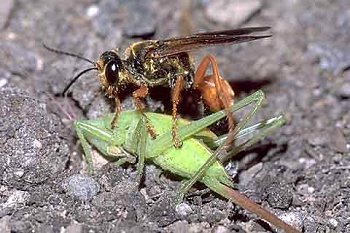Case Study: Sand Wasps and Fixed Action Patterns

A sand wasp with her prey
Sand wasps (Sphex languedocian) are insect predators that nest in the soil. After mating, a female excavates a vertical shaft and then digs out a small horizontal compartment that will be a “room” in her nursery. When her nest site is ready, the female goes hunting for prey (perhaps a cricket or a small caterpillar). She stings her victim to paralyze it, and then drags it back to her burrow. At the entrance, she drops the prey, runs down into the shaft and turns around, then comes out and pulls the prey down into her nest. She lays an egg near the prey’s body and continues hunting until she has stored enough fresh meat to feed a larval wasp. Her behavior is highly rigid and stereotypic, consisting of a series of fixed action patterns for hunting and provisioning the nest.
The French naturalist, J. Henri Fabré, conducted a classic experiment on this insect that clearly illustrates the character of innate behavior. Here is his own colorful description of the events, translated from French:
“At the moment when the Sphex is making her domicilliary visit, I take the grasshopper left at the entrance to the dwelling and place it a few inches further away. The Sphex comes up … looks here and there in astonishment, and, seeing the game too far off, comes out of the hole to seize it and bring it back to its right place. Having done this she goes down again, but alone.”
“I play the same trick again, and the wasp has the same disappointment on her arrival at the entrance. The victim is once more dragged to the hole, but the wasp always goes down alone.”
“This goes on as long as my patience is not exhausted.”
J. Henri Fabré, from Souvenirs Entomologiques
In Sphex languedocian, only the sight of prey within reach of the nest entrance will trigger the fixed action pattern of pulling prey into the burrow. But not all species are quite so inflexible. Like any other genetic trait, behavioral variability may exist among the members of a species. In Sphex ichumenoidies, a closely related species, some wasps will behave the same way as Fabré’s wasp, some will abandon the nest if prey is moved, and some will simply drag the prey down the hole without without repositioning it. Perhaps this sort of plasticity in genetically programmed behavior is an evolutionary precursor to intelligence!

